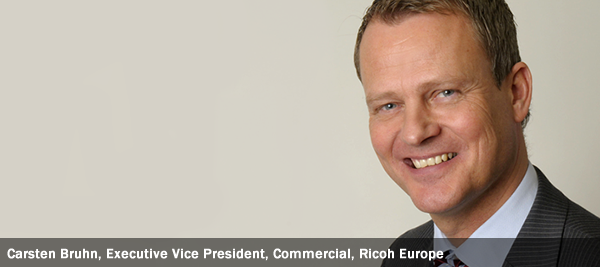The 1989 cult movie “Back to the Future II” predicted that the year 2015 would bring with it a world of hover-boards, flying cars and self-lacing trainers, writes Carsten Bruhn, Executive Vice President, Commercial at Ricoh Europe. While few of the flashy gadgets foreseen by the film’s creators have come into existence, 1989 proved a landmark year from which the way we communicate and work changed forever, thanks to the emergence of the World Wide Web.
It has undoubtedly revolutionised how we do business, and the raft of technology-led change we have faced since then has pushed the need to constantly monitor and review processes, tools and ways of working to the top of the business agenda. With over a quarter of a century having now passed since the birth of the Web, today’s businesses must understand and harness the power of digital in order to ride the next wave of technological evolution.
Already individuals, businesses and entire communities are embracing the power of the digital revolution. In a recent study commissioned by Ricoh Europe, 71 per cent of businesses leaders said they expected to reach a point of “digital maturity” – when an organisation uses sophisticated tools to drive performance and demonstrates a commitment to technology-led initiatives and digitally managed processes – within just four years.
Overall, business leaders seem convinced that digitisation can improve business decision-making and foster growth. This vote of confidence in the power of digital solutions is encouraging and sets the scene for an increased pace of digital transformation.
Yet obstacles remain. Part of the reason behind this is that, as digital technologies of all kinds have become embedded in the fabric of our lives, we have come to take them for granted. And this means we aren’t making the most of their astonishing potential. Digital tools such as e-invoicing or e-procurement might not sound revolutionary.
However, behind the scenes, they can make a huge difference to business efficiencies and processes – and in the long run, play a significant role in driving forward growth and competitiveness in Europe. For instance, the cost-savings of e-invoicing are significant. While it costs a company €11.10 to process a paper invoice, the same process managed digitally amounts to €4.70. On a broader scale, the European Commission predicts that the adoption of e-invoicing in public procurement will help save up to €2.3 billion across the EU.
The move towards greater digitisation of business-critical processes might seem like an overwhelming prospect for smaller businesses. But this is exactly why digitisation makes sense. For a small or medium-sized business (SMB), even a slight change can have a huge impact.
Many organisations are already aware of this and grasping the opportunity. Ricoh-sponsored research shows that small businesses across Europe have embraced key digital transformation initiatives – such as the digitisation of documents or the ability to work on documents from a work-supplied device – far faster than their larger counterparts. In addition, 79 per cent of small businesses say having put in place optimised processes through digitisation means they now have a competitive advantage.
It’s no coincidence that smart growth, driven in part by the digital economy, is one of the top three priorities under the European Commission’s Europe 2020 Strategy. Furthermore, it’s encouraging to see that, as part of its Work Programme for the year ahead, the new European Commission has promised to create the conditions for a vibrant digital environment, and to foster growth, innovation and social progress.
If properly nurtured and supported, digitisation can contribute significantly to these goals and to growth across a number of key sectors – including health, finance, public services, and education.
Increasing digitisation within education is especially important. The workplaces of the future need iWorkers – reliable and skilled employees who have 24/7 access to all the necessary information to meet the needs of the business and its clients – and it is the education sector which will foster this digital focus amongst the business leaders of tomorrow.
We’ve seen how Europe’s educators are the most optimistic and enthusiastic about the potential benefits of digitisation, compared with other sectors. But a broader lack of awareness about these benefits, concerns around changing processes, and an absence of the right partner support remain key obstacles.
Let’s make 2015 the year of accelerated change. By demonstrating the advantages of smart digital solutions at home, in school and at work, we can unlock savings and efficiencies which will set Europe on the path to increased prosperity and growth. This might not be as exciting as Marty McFly’s hover-board, but it is sure to leave a far-more lasting impact.
